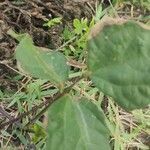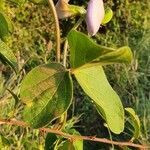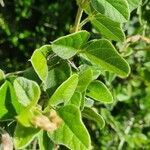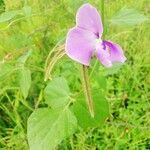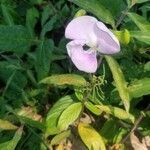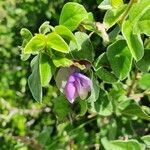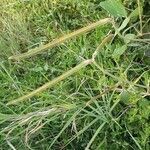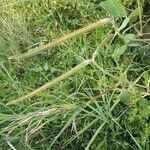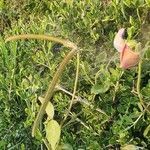Pantropical perennial. Stem herbaceous, climbing or trailing, from narrowly fusiform rootstock; whole plant dense to sparsely covered in retrorse, ferruginous or yellowish hairs, setaceous to aculeate. Leaflets mono-, bi-or trifoliolate, shape variable. Stipules lanceolate-cordate, lateral edges free at base. Inflorescence a contracted 2-4-flowered raceme, axillary; extrafloral nectaries arranged in a vertical row, normally three, the pedicels arising alternately from the base of a nectary (punctate gland); flowers magenta pink to purple, rarely white, on peduncles 50-350 mm long, axillary, with retrorse, ferruginous prickles densest at the apex; calyx lobes as long as or longer than tube; standard bilaterally asymmetric, oblate, repand, 20-30 mm x 20-40 mm, outer surface yellow to buff, standard enveloping rest of flower after pollination so collectors often describe flower as yellow; keel white or lilac, twisted to one side through 180o, inverted conical pocket on left side; stigma lateral, recessed papillae within 'bonnet-shaped' style elongation. Legumes erect, divergent, cylindric, 45-100 mm x 24-40 mm, black, densely ferruginous, hirsute, 10-18-seeded; seeds vary from light yellowish-brown to black or reddish, often speckled, approx. 2.5-4.5 mm x 2-2.5 mm, hilum eccentric, aril narrow to absent. Four varieties are recognized in southern Africa.
Perennial herbs, twining. Root woody, fusiform. Stems with spreading brown bristly hairs, glabrescent. Stipules ovate to ovate-lanceolate, 3-5 mm, cordate or auriculate at base, ciliate; petiole 1-11 cm; leaflets membranous, variable in shape, ovate to lanceolate, 4-9(-15) × 2-5(-8) cm, brown or gray pubescent on both surfaces, base rounded to cuneate, margin entire, sometimes slightly 3-lobed, apex acute or acuminate. Racemes axillary, 2-6-flowered, subumbellate; peduncles 5-20 cm. Bracteoles subulate, ca. 3 mm, caducous. Calyx with brown or white bristly hairs, rarely glabrescent; tube 5-7 mm; lobes linear or linear-lanceolate, 2-5 mm, upper 2 connate at base. Standard pink, purple, or partly yellow, sometimes with yellow or purple spots inside at base, 2-3.5 × 2-4 cm, emarginate; keel whitish or purplish, falcate, with beak incurved through 180°. Legumes erect, linear-terete, 4-14 cm × 2.5-4 mm, bristly. Seeds 10-18, yellowish, black, or brown to scarlet with black spots, oblong or oblong-reniform, 2-4.5 mm. Fl. Jul-Sep.
A variable climbing herb. It keeps growing from year to year. It has a narrow woody rootstock. This is dull white and wrinkled. The vines are 30 cm to 3 m long. They are hairy. The leaves have 3 leaflets and these are oval or long. They can be 3-16 cm long by 0.4-8 cm wide. They taper towards the tip and are rounded at the base. They leaf stalk is 2-11 cm long. The flowering stalks are in the axils of leaves and have 2-6 flowers. The flowering stalk is 5-36 cm long. The pea like flower has a standard which is 2-3 cm long and not the same on both sides. Flowers are pink or purple. The keel is paler with a beak curved back at the end and twisted to one side. The fruit are pods which are held erect. They are 4-14 cm long by 3-4 mm wide and covered with short brown hairs. There are 10-18 seeds. The seeds are light brown to black. They are kidney shaped and 3-4 mm long by 2 mm wide.
Slender twining vines; stems mostly retrorsely pilose with long tawny hairs; roots tuberous. Leaves pinnate trifoliolate; leaflets mostly narrowly ovate, mostly 5-9 cm long, 2-3.5 cm wide, apically acute mucronulate, basally obtuse or round-ed, thin, pilose with white hairs, mostly glabrescent but remaining ciliate on the margins and the major veins beneath; petiolules 2-3 mm long, tawny pilose; petioles retrorsely hispid, shorter than the terminal leaflet; stipels subulate or narrowly acuminate, mostly ca. 2 mm long; stipules acute, striate, 4-8 mm long, hispid, auriculate. Inflorescences axillary, few flowered, 20-30 cm long; peduncle erect, retrorsely pubescent, the flowers congested at the apex; bracts and brac-
Pantropical perennial, 0.1-1.2 m high/long; ferruginously patent-hairy. Leaves trifoliolate. Leaflets varying from linear to lanceolate or ovate to round. Stipules elongated laterally beyond point of attachment, base cordate. Inflorescences axillary, contracted, 2-4-flowered; peduncles 50-350 mm long; extrafloral nectaries 3, in vertical row, between pedicel bases. Calyx with lobes ± as long as tube. Petals: standard ± rotund; keel twisted through 180°, inverted, conical pocket on left side. Style prolongation apparently obtuse; stigma covered by bonnet-shaped flap of tissue. Flowering time Oct.-Apr. Pod ferruginously hairy, up to 100 mm long. Seeds 10-18.
Leaflets 3, 2.5–16.5 × 0.4–8.3 cm, ovate to lanceolate or in some variants elliptic to linear-oblong, acute or acuminate at the apex, rounded or truncate at the base, usually entire but rarely slightly lobed, nearly glabrous to pubescent to velvety on both surfaces; venation ± raised and reticulate on both surfaces; petiole 1.5–11 cm long; rhachis 0.4–3 cm long; stipules 5–13 mm long, lanceolate, multinerved, prolonged and subcordate or shortly auriculate at the base.
teoles caducous; pedicels 1-2 mm long. Flowers blue or lavender turning white or yellow; calyx short pubescent, 9-13 mm long, campanulate, the 5 teeth acu-minate subulate, about as long as the tube; standard 2-2.5 cm long, the keel incurved. Legume linear, 7-10 cm long, ca. 5 mm wide, slightly compressed, maturing black, densely pilose, somewhat glabrescent; seeds oblong, 4-5 mm long, dark, shiny, the hilum white.
Standard bilaterally asymmetrical, with 2 parallel widely spaced appendages, rarely without appendages; keel twisted towards the right, asymmetrical, the beak incurved through 180°, the left-hand petal with a marked conical pocket 4–6 mm long.
Sprawling, usually twining, retrorsely hairy or glabrescent subshrub. Leaves pinnately 3-foliolate, leaflets linear-oblong (sometimes sublanceolate) to ovate. Flowers 2-4 on elongate peduncles, greenish white tinged magenta.
Flower pink to purple, rarely white tinged with mauve, 1.7–2.6 cm long; pedicel 1–2 mm long, not expanding as the pod matures; bracteoles linear-lanceolate, 1-nerved.
Calyx with long brown or whitish bristly and also short white hairs, rarely glabrescent; tube 4–7 mm long; lobes subequal, the upper pair joined at the base only.
Pods 8–14 cm × 3–5 mm, linear-cylindrical, scabrous, covered with short or long brown bristly hairs, with a straight beak.
Peduncle 4.5–36 cm long; rhachis 0–1.5 cm long, 1–4-noded, internodes 2–6 mm long.
Perennial climbing or trailing herb, 0.3–6 m long, from a narrow woody rootstock.
Seed with hilum slightly excentric; aril vestigial or not developed.
Stem sparsely to very densely covered with brown hairs or bristles.
